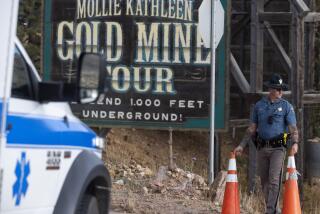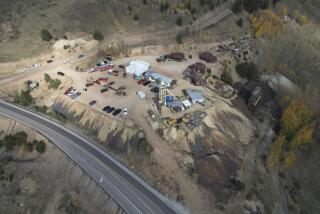MTA Tunneling Machine Beset by New Mishap
- Share via
Despite assurances last week that a giant subway tunneling machine trapped under the Santa Monica Mountains for a month and a half had been freed and would resume work, Metro Rail officials said Monday that a 10-foot slab of rock fell on it during the weekend and will put the machine out of action for several more days.
The 300-foot-long machine has been wedged 220 feet below Fredonia Street in the Cahuenga Pass since it was allowed to stand idle for four days over the Fourth of July weekend. Metro Rail officials’ embarrassment over the mishap has grown as the weeks have passed.
At a meeting Monday morning of the construction committee of the Metropolitan Transportation Authority directors, the agency’s deputy construction chief, John Adams, exasperated at least two board members by stating that he did not know whether tunneling would resume that day, as promised.
“Our construction managers should be responsible and knowledgeable enough to answer simple questions,” said committee Vice Chairwoman Vivien Bonzo, expressing her frustration in an interview after the meeting.
“This is the very thing that creates our concern in them.”
Added Bonzo, who owns an Olvera Street restaurant: “I try to hold them to the same standards as my busboys, and they haven’t met that standard.”
MTA spokeswoman Andrea Greene said a slab of rock had fallen on the roof of the tunnel boring machine’s shield “late Saturday or early Sunday” as workers excavated around it to clear space to make a modification.
Greene said the rock--10 feet long, 2 feet wide and 2 feet thick--did not damage the shield. Miners will need until the end of the week to remove the debris and make mechanical changes to the machine, she said.
MTA project manager Charles Stark has said that the tunneling machine became stuck when miners took four days off to celebrate Independence Day, then returned and discovered that they had parked it in a zone of “squeezing ground.” In such zones of heavily faulted rock, he said, the release of “stored energy” expands the ground inside a tunnel--shrinking the tunnel’s diameter.
On Sunday, The Times reported that inspection reports filed by the MTA’s construction management consultants showed that the tunnel had been shrinking and suffering cave-ins for at least three weeks before the July 4 weekend. Independent mining experts said this should have alerted the firm digging the tunnel--Traylor Bros./Frontier-Kemper--that the ground was coming in on the machine.
The Times also reported that a panel of MTA construction executives and engineering consultants had allowed the contractor, as conditions warranted, to substitute weaker four-inch-wide tunnel support ribs for six-inch-wide ribs specified in the original contract.
MTA board members were not told about the contractor’s trouble until 10 days after the machine had gotten stuck, when Stark and tunneling consultant Z. Daniel Eisenstein informed the construction committee that the mishap was “unexpected but not unheard of.”
Stark said Monday that he was aware that the tunneling contractor had problems installing steel ribs before July, but did not believe that it merited mention to board members. He said its importance was a matter of “interpretation.”
More to Read
Sign up for Essential California
The most important California stories and recommendations in your inbox every morning.
You may occasionally receive promotional content from the Los Angeles Times.










